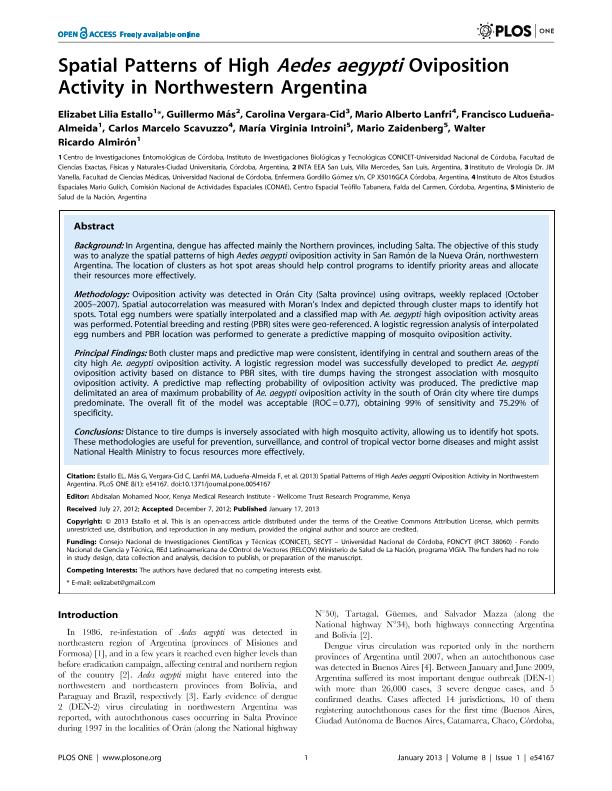Artículo
Spatial patterns of high Aedes Aegypti oviposition activity in northwestern Argentina
Estallo, Elizabet Lilia ; Más, Guillermo; Vergara Cid, Carolina
; Más, Guillermo; Vergara Cid, Carolina ; Lanfri, Mario Alberto; Ludueña Almeida, Francisco; Scavuzzo, Carlos Marcelo; Introini, María Virginia; Zaidenberg, Mario; Almiron, Walter Ricardo
; Lanfri, Mario Alberto; Ludueña Almeida, Francisco; Scavuzzo, Carlos Marcelo; Introini, María Virginia; Zaidenberg, Mario; Almiron, Walter Ricardo
 ; Más, Guillermo; Vergara Cid, Carolina
; Más, Guillermo; Vergara Cid, Carolina ; Lanfri, Mario Alberto; Ludueña Almeida, Francisco; Scavuzzo, Carlos Marcelo; Introini, María Virginia; Zaidenberg, Mario; Almiron, Walter Ricardo
; Lanfri, Mario Alberto; Ludueña Almeida, Francisco; Scavuzzo, Carlos Marcelo; Introini, María Virginia; Zaidenberg, Mario; Almiron, Walter Ricardo
Fecha de publicación:
01/2013
Editorial:
Public Library Of Science
Revista:
Plos One
ISSN:
1932-6203
Idioma:
Inglés
Tipo de recurso:
Artículo publicado
Clasificación temática:
Resumen
Background: In Argentina, dengue has affected mainly the Northern provinces, including Salta. The objective of this study was to analyze the spatial patterns of high Aedes aegypti oviposition activity in San Ramo´n de la Nueva Ora´n, northwestern Argentina. The location of clusters as hot spot areas should help control programs to identify priority areas and allocate their resources more effectively.
Methodology: Oviposition activity was detected in Ora´n City (Salta province) using ovitraps, weekly replaced (October 2005–2007). Spatial autocorrelation was measured with Moran’s Index and depicted through cluster maps to identify hot spots. Total egg numbers were spatially interpolated and a classified map with Ae. aegypti high oviposition activity areas was performed. Potential breeding and resting (PBR) sites were geo-referenced. A logistic regression analysis of interpolated egg numbers and PBR location was performed to generate a predictive mapping of mosquito oviposition activity.
Principal Findings: Both cluster maps and predictive map were consistent, identifying in central and southern areas of the city high Ae. aegypti oviposition activity. A logistic regression model was successfully developed to predict Ae. aegypti oviposition activity based on distance to PBR sites, with tire dumps having the strongest association with mosquito oviposition activity. A predictive map reflecting probability of oviposition activity was produced. The predictive map delimitated an area of maximum probability of Ae. aegypti oviposition activity in the south of Ora´n city where tire dumps predominate. The overall fit of the model was acceptable (ROC = 0.77), obtaining 99% of sensitivity and 75.29% of specificity.
Conclusions: Distance to tire dumps is inversely associated with high mosquito activity, allowing us to identify hot spots. These methodologies are useful for prevention, surveillance, and control of tropical vector borne diseases and might assist National Health Ministry to focus resources more effectively.
Archivos asociados
Licencia
Identificadores
Colecciones
Articulos(IIBYT)
Articulos de INSTITUTO DE INVESTIGACIONES BIOLOGICAS Y TECNOLOGICAS
Articulos de INSTITUTO DE INVESTIGACIONES BIOLOGICAS Y TECNOLOGICAS
Citación
Estallo, Elizabet Lilia; Más, Guillermo; Vergara Cid, Carolina; Lanfri, Mario Alberto; Ludueña Almeida, Francisco; et al.; Spatial patterns of high Aedes Aegypti oviposition activity in northwestern Argentina; Public Library Of Science; Plos One; 8; 1; 1-2013; 1-8
Compartir
Altmétricas



